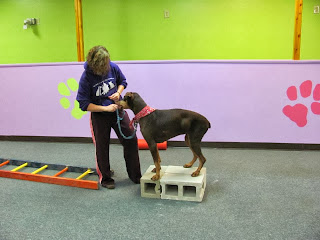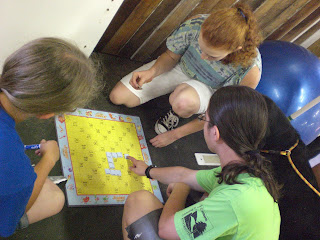As we started to teach our dog parkour classes, we quickly recognized that urban agility (or dog parkour) had the ability to help a population of dogs that was normally overlooked when designing the average dog class. This group are the elderly or injured dogs who are in need of physical rehabilitation and strengthening to become pain free and improve their quality of life.
The structure and goals of a parkour class allows us to tailor each exercise for the individual needs of the dog. This, along with the fact that our classes are joint taught by a veterinarian, allows us to design exercises to increase strength, proprioception, and balance in dogs who are recovering from injury or have limited mobility due to age. The benefit parkour class has over a more traditional dog sport is we have the ability to ensure there isn’t the impact on joints common in competitive sports.
 Many of these dogs’ owners are given exercises by their veterinarians to help improve their mobility and strength but as they often lack creativity or are tedious there is often difficulty in having enough compliance to see improvement. This isn’t really the fault of the owner as we will be the first to admit that leash walks and foot raises can get boring quickly. Parkour has the advantage that it is fun for both handler and dog, so helps to increase owner compliance. It is simply more fun to strengthen your dog’s back legs using a surfboard than with leg raises or walking up the stairs.
Many of these dogs’ owners are given exercises by their veterinarians to help improve their mobility and strength but as they often lack creativity or are tedious there is often difficulty in having enough compliance to see improvement. This isn’t really the fault of the owner as we will be the first to admit that leash walks and foot raises can get boring quickly. Parkour has the advantage that it is fun for both handler and dog, so helps to increase owner compliance. It is simply more fun to strengthen your dog’s back legs using a surfboard than with leg raises or walking up the stairs.
Also, as participants are spending at least an hour each week dedicated only to working with their dog, it isn’t long until there are signs of improvement. The group environment at class is very helpful in this respect as both the instructors and the other participants are quick to point out when they notice improvement in any of the dogs. When improvements aren’t being made, the benefit to having both a certified dog trainer and a veterinarian as instructors is that a new plan can quickly be formulated.
It is important to note that physical rehabilitation (including using parkour in this way) is considered to be a medical treatment and as such needs to be done under the guidance of a veterinarian.
In an effort to highlight the improvements that can be made when using parkour for physical rehabilitation, we are going to introduce two different dogs with different injuries and follow them through their rehab process.
DAZZ
Dazz is a 12 year old Doberman diagnosed with Wobblers. It wasn’t very apparent until a hiking injury made clear a lack of hind feet awareness, and caused a loss of overall muscle. She tires easily, and will become stumbly in the front and drag her back feet more than normal. Stairs are a big challenge: going up is a strain on her front legs as she pulls herself up, a long set will sometimes cause her to get “stuck” in a puppy push up, and going down gravity is stronger than Dazz and can cause her to bail and jump to the bottom or lose control and fall down the rest. I would like to be able to confidently take her for walks and off-leash visits to the park without worrying about her trainwrecking in the grass or struggling to get up the stairs to bed afterward.
Vet note: Dazz has been diagnosed with Wobbler Syndrome or cervical spondylomyelopathy (don’t let the scary vet term frighten you!) which means that something in her neck is pressing on her spinal cord. This is a common problem in large breed dogs (particularly dobermans and great danes) and results in a “wobbly” gait. Just as is seen with Dazz, this is usually more noticeable in the hind end, but may progress to front leg signs over time. She has limited to no conscious proprioception in her hind legs and deficits to her conscious proprioception in her front legs. She has an overall reduction in strength and muscle mass, most notably in the hind end. Typical treatment options for wobblers includes both surgery and medical management. As Dazz also has Von Willebrand's disease (which makes her blood not clot appropriately) she is a poor candidate for surgical management. As such, we are attempting to manage her clinical signs and the pain and inflammation in her spinal cord with medications and physical rehabilitation instead. She is currently on 200mg Gabapentin three times a day, 75mg Thyroxine once a day (for previously diagnosed hypothyroid disease), and 1mg DES twice a week (for incontinence). The goal of her rehabilitation is to maintain, if not increase, her conscious proprioception and strength in all four limbs to allow her to continue to maintain or improve her quality of life.
CALEB
Caleb is a 5 year old, 45 lb mix breed adopted from a shelter at 8 months old. Caleb started training for agility when he was a year old, and took weekly classes for three years. He stopped taking agility classes in May 2013 because of stress and periodic limping and has been taking obedience classes since this time. Caleb has been diagnosed with luxating patellas and will limp after exercise. Caleb has been taking fluoxetine since July 2013, and has seen significant improvement with anxiety and dog reactivity.
Vet note: Caleb has luxating patellas (grade I/IV on the left and a grade II/IV on the right). This means that his kneecaps will pop out of place when he moves incorrectly and that his right knee is worse than his right. Often surgery is required to make a definitive fix of this issue. The hope is that by increasing rear end strength and awareness we will delay the time until he needs surgery while keeping him pain free. At this time he is on no medications for pain and only limps after strenuous exercise. His body condition score is a 2.5/5. He was also diagnosed with generalized anxiety and fear reactivity towards unfamiliar dogs and given a treatment plan including behavior modification exercises and 20mg of Fluoxetine once a day.
Authored by: Abigail Curtis DVM, Karin Coyne CPDT- KA, Gennie Abbiss
 Walking backward. This requires a lot of strength in the rear. When she gets tired, she’ll back a few steps into a sit, so we’re trying to slowly build strength and endurance at this.
Walking backward. This requires a lot of strength in the rear. When she gets tired, she’ll back a few steps into a sit, so we’re trying to slowly build strength and endurance at this.  Stepping into/out of things. We've been stepping into a round sled with raised edges as well as a laundry basket. She was able to step one foot at a time into the laundry basket - lifting her back feet up and over the edge! This requires a ton of strength and balance for her, so she was only able to do it a few times, but I was impressed!
Stepping into/out of things. We've been stepping into a round sled with raised edges as well as a laundry basket. She was able to step one foot at a time into the laundry basket - lifting her back feet up and over the edge! This requires a ton of strength and balance for her, so she was only able to do it a few times, but I was impressed! 











